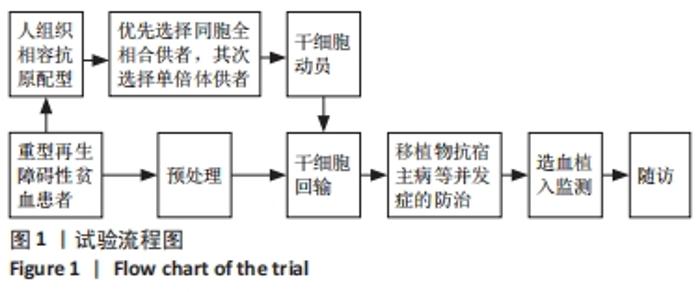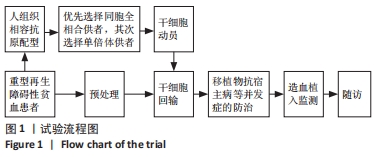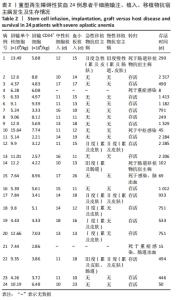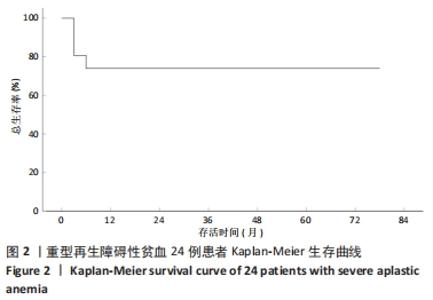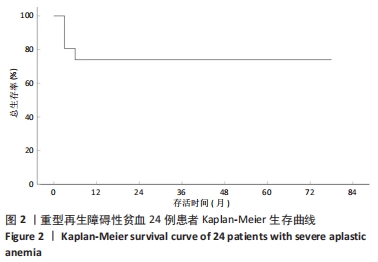[1] CHEN M, LIU C, ZHUANG J, et al. Long-term follow-up study of porcine anti-human thymocyte immunoglobulin therapy combined with cyclosporine for severe aplastic anemia. Eur J Haematol. 2016; 96(3):291-296.
[2] ALASHKAR F, OELMÜLLER M, HERICH-TERHÜRNE D, et al. Immunosuppressive therapy (IST) in adult patients with acquired aplastic anemia (AA): A single-center experience over the past 15 years. Eur J Haematol. 2019;103(1):18-25.
[3] VIOLLIER R, PASSWEG J, GREGOR M, et al. Quality-adjusted survival analysis shows differences in outcome after immunosuppression or bone marrow transplantation in aplastic anemia. Ann Hematol. 2005; 84(1):47-55.
[4] GEORGES GE, DONEY K, STORB R. Severe aplastic anemia: allogeneic bone marrow transplantation as first-line treatment. Blood Adv. 2018; 2(15):2020-2028.
[5] BACIGALUPO A. How I treat acquired aplastic anemia. Blood. 2017;129(11): 1428-1436.
[6] BACIGALUPO A. Alternative donor transplants for severe aplastic anemia. Hematology Am Soc Hematol Educ Program. 2018;2018(1): 467-473.
[7] 张之南,沈悌.血液病诊断及疗效标准[M].3版.北京:科学出版社,2007.
[8] BACIGALUPO A, SOCIÉ G, HAMLADJI RM, et al. Current outcome of HLA identical sibling versus unrelated donor transplants in severe aplastic anemia: an EBMT analysis. Haematologica. 2015;100(5):696-702.
[9] GALLO S, WOOLFREY AE, BURROUGHS LM, et al. Marrow grafts from HLA-identical siblings for severe aplastic anemia: does limiting the number of transplanted marrow cells reduce the risk of chronic GvHD? Bone Marrow Transplant. 2016;51(12):1573-1578.
[10] KILLICK SB, BOWN N, CAVENAGH J, et al. Guidelines for the diagnosis and management of adult aplastic anaemia. Br J Haematol. 2016; 172(2):187-207.
[11] XU L, CHEN H, CHEN J, et al. The consensus on indications, conditioning regimen, and donor selection of allogeneic hematopoietic cell transplantation for hematological diseases in China-recommendations from the Chinese Society of Hematology. J Hematol Oncol. 2018;11(1): 33.
[12] Pierri F, Dufour C. Management of aplastic anemia after failure of frontline immunosuppression. Expert Rev Hematol. 2019;12(10):809-819.
[13] XU LP, WANG SQ, WU DP, et al. Haplo-identical transplantation for acquired severe aplastic anaemia in a multicentre prospective study. Br J Haematol. 2016;175(2):265-274.
[14] LU Y, SUN RJ, ZHAO YL, et al. Unmanipulated Haploidentical Hematopoietic Stem Cell Transplantation Achieved Outcomes Comparable With Matched Unrelated Donor Transplantation in Young Acquired Severe Aplastic Anemia. Biol Blood Marrow Transplant. 2018; 24(9):1881-1887.
[15] 肖方,刘强,范丹,等.一线与挽救性单倍体相合造血干细胞移植治疗重型再生障碍性贫血患者的疗效比较[J].中国实验血液学杂志,2020,28(5):1683-1688.
[16] XU LP, JIN S, WANG SQ, et al. Upfront haploidentical transplant for acquired severe aplastic anemia: registry-based comparison with matched related transplant. J Hematol Oncol. 2017;10(1):25.
[17] GENG C, LIU X, CHEN M, et al. Comparison of frontline treatment with intensive immunosuppression therapy and HLA-haploidentical hematopoietic stem cell transplantation for young patients with severe aplastic anemia - A meta analysis. Leuk Res. 2020;88:106266.
[18] KUMAR R, KIMURA F, AHN KW, et al. Comparing Outcomes with Bone Marrow or Peripheral Blood Stem Cells as Graft Source for Matched Sibling Transplants in Severe Aplastic Anemia across Different Economic Regions. Biol Blood Marrow Transplant. 2016;22(5):932-940.
[19] BACIGALUPO A, SOCIÉ G, SCHREZENMEIER H, et al. Bone marrow versus peripheral blood as the stem cell source for sibling transplants in acquired aplastic anemia: survival advantage for bone marrow in all age groups. Haematologica. 2012;97(8):1142-1148.
[20] KIM H, LEE KH, SOHN SK, et al. Effect of Stem Cell Source and Dose on Allogeneic Hematopoietic Stem Cell Transplantation in Adult Patients with Idiopathic Aplastic Anemia: Data from the Korean Aplastic Anemia Trials. Acta Haematol. 2020;143(3):232-243.
[21] 危薇,丁丽,郑晓丽,等.移植物成分对单倍体相合造血干细胞移植治疗再生障碍性贫血后急性移植物抗宿主病的影响[J].中国实验血液学杂,2018,26(5):1442-1446.
[22] GIAMMARCO S, PEFFAULT DE LATOUR R, SICA S, et al. Transplant outcome for patients with acquired aplastic anemia over the age of 40: has the outcome improved? Blood. 2018;131(17):1989-1992.
[23] BAI LY, CHIOU TJ, LIU JH, et al. Hematopoietic stem cell transplantation for severe aplastic anemia--experience of an institute in Taiwan. Ann Hematol. 2004;83(1):38-43.
[24] YaNG D, YANG J, HU X, et al. Aplastic Anemia Preconditioned with Fludarabine, Cyclophosphamide, and Anti-Thymocyte Globulin. Ann Transplant. 2019;24:461-471.
[25] SHIN SH, JEON YW, YOON JH, et al. Comparable outcomes between younger (≤40 years) and older (>40 years) adult patients with severe aplastic anemia after HLA-matched sibling stem cell transplantation using fludarabine-based conditioning. Bone Marrow Transplant. 2016; 51(11):1456-1463.
[26] SHETH VS, POTTER V, GANDHI SA, et al. Similar outcomes of alemtuzumab-based hematopoietic cell transplantation for SAA patients older or younger than 50 years. Blood Adv. 2019;3(20):3070-3079.
[27] MARSH JC, GUPTA V, LIM Z, et al. Alemtuzumab with fludarabine and cyclophosphamide reduces chronic graft-versus-host disease after allogeneic stem cell transplantation for acquired aplastic anemia. Blood. 2011;118(8):2351-2357.
[28] KAKO S, KANDA Y, ONIZUKA M, et al. Allogeneic hematopoietic stem cell transplantation for aplastic anemia with pre-transplant conditioning using fludarabine, reduced-dose cyclophosphamide, and low-dose thymoglobulin: A KSGCT prospective study. Am J Hematol. 2020;95(3):251-257.
[29] YE L, ZHANG F, KOJIMA S. Current insights into the treatments of severe aplastic anemia in China. Int J Hematol. 2020;112(3):292-299.
|
